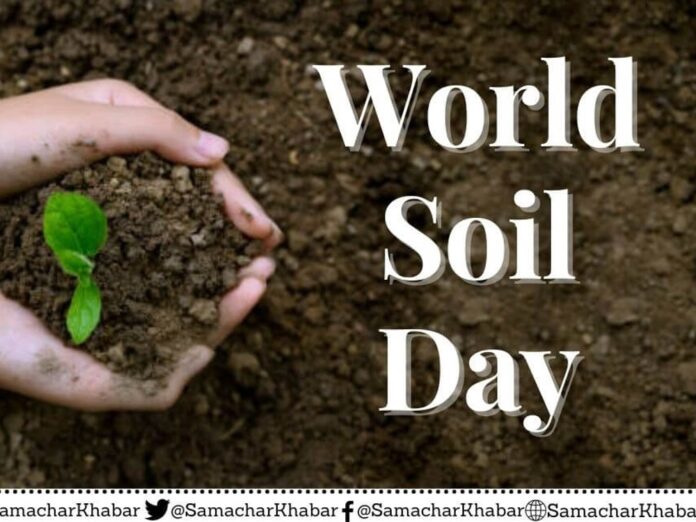
An article presented by the Ministry of Blue and Green Economy, Agriculture and National Food Security with contributions from Dr. Al-Mario Casimir Technical Officer Extension (Ag.); Ryan Anselm MSc Technical Officer Projects & Services, Annie Edwards Physical Planning Division, and Dr. Dave Lloyd Soil Ecologist/Independent Consultant.
Background
The Coat of Arms of the Commonwealth of Dominica bears the inscription ‘ Apres Bondie C’est La Ter’, (after God the Earth), which emphasizes the importance of the soil in the island with its economy based on agriculture. Soil is one of the most significant parts of the ecosystem. Soil organisms help soils store carbon, nurture plants, degrade contaminants, and reduce Green House Gas emissions. Nowadays, soil biodiversity is under pressure worldwide since unsustainable soil management has affected life below ground.

Actions should be taken to protect soil biodiversity! If water is the source of life, then the soil is the mother of all creatures. Healthy soils are a prerequisite to achieving the United Nations’ Sustainable Development Goals and form the basis of the Food and Agriculture Organization’s (FAO) Four Betters – better production, better nutrition, a better environment, and a better life, leaving no one behind. As former president, Franklin D. Roosevelt[1] once said, “A nation that destroys its soil destroys itself. Forests are the lungs of our land, purifying the air and giving fresh strength to our people.”
World Soil Day[2] (WSD) is held annually on 5 December as a means to focus attention on the importance of healthy soil and to advocate for the sustainable management of soil resources. World Soil Day 2021 and its campaign “Halt soil salinization, boost soil productivity” aims to raise awareness of the importance of maintaining healthy ecosystems and human well-being by addressing the growing challenges in soil management, fighting soil salinization, increasing soil awareness, and encouraging societies to improve soil health. International days and weeks are occasions to educate the public on issues of concern, mobilize political will and resources to address global problems, and celebrate and reinforce the achievements of humanity. World Soil Day as an international day to celebrate Soil was recommended by the International Union of Soil Sciences (IUSS) in 2002. Under the leadership of the Kingdom of Thailand and within the framework of the Global Soil Partnership, FAO has supported the formal establishment of World Soil Day as a global awareness-raising platform.
Within the theme of this year’s observance, it is well known that soils can become salt-affected very quickly for a variety of reasons: due to human mismanagement, excessive or inappropriate use of fertilizers, deforestation, sea level rises, a shallow water table which affects the root-zone, or seawater intrusion into groundwater that is then used for irrigation. Climate change is also raising the stakes, with models suggesting that global drylands could expand by as much as 23 percent – mostly in developing countries – by the end of the century.
Salts are present naturally in soils and water, and they move freely through the soil. Naturally saline soils may support rich ecosystems, but natural processes such as droughts and human activities, especially improper irrigation, can increase how many salts are in soils, a process that is called salinization. Soil salinization and sodification are major soil degradation processes threatening ecosystem and are recognized as being amongst the most important problems at a global level for agricultural production, food security and sustainability in arid and semi-arid regions. Soil salinization breaks down our soils and reduces their ability to help our food grow. Human-induced salt-affected soils (a term that describes saline, sodic, and saline-sodic soils) are less fertile and less productive and therefore pose a threat to the global fight against hunger and poverty. They also reduce water quality and soil biodiversity while increasing soil erosion.
Salt-affected soils (SAS) have serious impacts on soil functions, such as in the decrease in agricultural productivity, water quality, soil biodiversity, and soil erosion. Salt-affected soils have a decreased ability to act as a buffer and filter against pollutants. Salt-affected soils reduce both the ability of crops to take up water and the availability of micronutrients. They also concentrate ions that are toxic to plants and may degrade the soil structure. With current information from 118 countries covering 85% of global land area[3], it shows that more than 424 million hectares of topsoil (0-30 cm) and 833 million hectares of subsoil (30-100 cm) are salt-affected: 85% of salt-affected topsoils are saline, 10% are sodic and 5% are saline-sodic. In addition, 62% of salt-affected subsoils are saline, 24% are sodic and 14% are saline-sodic.
These estimates based on the submitted data show that more than 3% of global topsoils and more than 6% of global subsoils are affected by salinity or sodicity. More than two-thirds of global SAS are found in arid and semi-arid climatic zones: 37% of SAS are located in arid deserts, 27% of SAS are distributed in the arid steppe (half in cold arid steppe and half in the hot arid steppe. Most of them can be found in naturally arid or semi-arid environments in Africa, Asia, and Latin America. However, 20 to 50 percent of irrigated soils in all continents are too salty, meaning over 1.5 billion people worldwide face significant challenges in growing food due to soil degradation.
It is well known that there is a direct risk of erosion, soil structure deterioration, soil fertility loss, hydrological impacts, as well as loss of biodiversity from on-farm agricultural practices which are unsustainable. The mountainous terrain of the country and variations in soil quality means that only a small percentage of the land (20%) is suitable for agriculture although an estimated 25% of the land is being farmed and slopes of 30o or more are found in at least 60% of the country. Consequently, the island is ecologically fragile and vulnerable to natural disasters.
[2] https://www.un.org/en/events/desertification_decade/whynow.shtml


